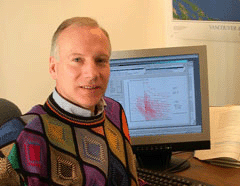|
 |
 |
 |
 |
 |
 |
 |
 |
 |
Population and Ecological Models |
|
|
 |
 |
| |
|
 |
  |
|
|
| |
 |
Welcome |
|

Note to Visitors
This website is offered with
only some of the identified models available for downloading at
this time.
You will find some links not
yet functional, and some content absent, during your visit.
Site last updated:
October 01, 2004
|
| |
 |
|
|
| |
|
| This
is the Home Page of Dr. Barry D. Smith, Research
Scientist with the Canadian
Wildlife Service, and Adjunct Professor with the Centre
for Wildlife Ecology at Simon Fraser University. I specialize
in population, ecological and statistical modelling.
|
 |
| I
endeavour to bring populations and population processes to life
by proxy using computer modelling by combining elements of the
disciplines of biology, ecology, logic, mathematics and statistics.
Typically these models are developed as Microsoft Visual Basic 6.0 ©
or Microsoft EXCEL © or applications. |
 |
| I
have been fortunate to have investigated a broad range of modelling
problems concerning plant, invertebrate, fish, bird and wildlife
biology, and their ecology and conservation. These endeavours
were pursued at the Pacific Biological Station in Nanaimo, British
Columbia and l'Institut Maurice Lamontange in Mont-Joli, Québec (Canadian
Department of Fisheries and Oceans Canada), and the Pacific
Wildlife Research Centre in Delta, British Columbia (Canadian
Wildlife Service), where I now work. I have also worked at
the Department of Fish, Wildlife and Conservation Biology at
the University of California, Davis, California, and for the
Canadian Provinces of Nova Scotia and British Columbia. |
 |
| This
website provides free and easy access to some of my Visual Basic
© models to practitioners who may find them useful in their
biological, ecological, assessment and conservation work.
Some models come accompanied by associated peer-reviewed
journal publications, others by a user's guide. Some are assumed,
probably naïvely on my part, to be self-explanatory through
interactive documentation. However, I have provided an explanation
of SmartStats ©, the
statistical framework within which the statistical models have
been developed. |
 |
| These
models have been all been well alpha-tested, but users should
still consider themselves to be beta-testers. As such, all
models are offered without any explicit or implied warranty
covering any form of defect in logic, programming or function.
Nevertheless, I continually endeavour to maintain all programs
as bug-free as possible, especially in response to users' queries. |
 |
| The
following is a compilation of the plants, invertebrates, fish,
birds, and humans, as populations or as components of natural
and exploited ecological systems, that I have had the good fortune
to have studied either directly or indirectly with data and colleagues. |
 |
Plants:
Irish Moss Chondrus crispus
The kelps Laminaria longicruris and L. digitata
Marine and terrestrial plant communities, i.e., species richness |
 |
Invertebrates:
Atlantic Lobster Homarus americanus
Blue Mussel Mytilus edulis
Dungeness Crab Cancer magister
Neon Flying Squid Ommastrephes bartrami
Green Sea Urchin Strongylocentrotus dröebachiensis
Northern Whelk Buccinum undatum
Red Sea Urchin Strongylocentrotus franciscanus
Sea Scallop Placopectin magellanicus
Snow Crab Chionoecetes opilio
Southern King Crab Lithodes santolla
Southern Stone Crab Paralomis granulosa
The barnacle Notobalanus flosculus |
 |
Fish:
Atlantic Herring Clupea harengus
Atlantic Redfish Sebastes spp.
Chinook Salmon Oncorhynchus tshawytscha
Chum salmon Oncorhynchus keta
Coho Salmon Oncorhynchus kisutch
Lingcod Ophiodon elongatus
Pacific Hake (whiting) Merluccius productus
Steelhead Trout Oncorhynchus mykiss
Walleye Pollock Theragra chalcogramma |
 |
Birds:
Barrow’s Goldeneye Bucephala islandica
Cassins Auklet Ptychoramphus aleuticus
Common Tern Sterna hirundo
Dunlin Calidris alpina
Great Blue Heron Ardea herodias fannini
Northern Flicker Colaptes auratus
Pacific Black Brant Branta bernicla nigricans
Red-naped Sapsucker Sphyrapicus nuchalis
Surf Scoter Melanitta perspicillata
Western Sandpiper Calidris mauri |
 |
Primates:
Anglers Homo sapiens |
 |
 |
|
 |

|
|
|
|
